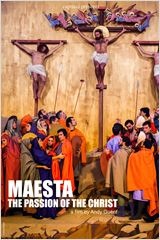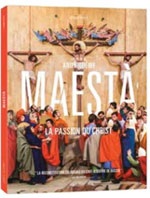Maesta - La Passion du Christ
-
Réalisé par Andy Guérif • Écrit par Andy Guérif
-
France • 2015 • 60 minutes • HD • Couleur
- Réalisation :
Andy Guérif - Écriture :
Andy Guérif - Image :
Steven Le Guellec - Son :
Gwenaël Labarta - Montage :
Cécile Pradere
- Production (structure) :
Capricci Films - Ayant droit :
Capricci Films
- N° ISAN :
non renseigné
Résumé
De la peinture de Duccio di Buoninsegna, Andy Guérif nous avait déjà donné une lecture inattendue avec Cène (FID 2004), le célèbre panneau peint prenant littéralement corps sous nos yeux. Nous voici à nouveau avec le grand œuvre du Siennois peint à l’orée du XIVe siècle, immense polyptique avec Marie en majesté, "La Maesta".
Que faire d’un tel monument, aujourd’hui ? Tel est ici le projet : tracer des possibles, de la peinture vers le cinéma, de la narration gothique à l’imagerie contemporaine. De ce retable monumental, foisonnant, le cinéaste retient les 26 panneaux du verso narrant la Passion du Christ. Et nous voilà pris dans l’image, son mouvement, à suivre, d’une vignette à l’autre, le cheminement interne complexe, insolite, du tableau. S’enchaînent les séquences de la Passion réinterprétées successivement. Méticuleusement reconstitués, les décors, d’abord vides de personnages, un par un s’animent du brouhaha de ceux qui s’y installent, puis, miracle : arrêt sur image. Et, à nouveau, ce petit monde quitte la scène à destination de la vignette suivante.
Ainsi le tableau se fait en cheminant, chaque image devenant l’acmé figée de cet ensemble dont on a sous les yeux les stases passées comme nous devinons les images à venir. Double mouvement de souvenir et de projection, où le montage en splitscreen dialogue avec le procédé narratif du trecento, où, d’une image à l’autre, les figures du temps et de l’événement se télescopent. Inactuel et contemporain. (Nicolas Féodoroff, FIDMarseille 2015)
Andy Guérif had already given us an unexpected reading of Duccio’s painting in Cène (FID 2004), the famous painted panel literally taking form in front of our eyes. Here we are again with the great work of the Sienese artist painted at the turn of the 14th century, a huge polyptych with Mary in majesty, La Maesta. What to do with such a monument today? That is the project here: tracing possibilities, from painting to cinema, from Gothic narrative to contemporary imagery. The fi lmmaker concentrates on the 26 back panels of this abundant monumental altarpiece narrating the Passion of Christ. And we are caught in the picture, its movement, following, from one vignette to the next, the unusual and complex inner journey of the painting. Sequences follow of the Passion reinterpreted in succession. Meticulously restored, the decors, initially empty of characters, one by one come alive from the hubbub of those who settle there, and then, a miracle: a fixed image. And, again, everybody quits the scene to go on to the next vignette. Thus the painting is explored in stages; each image becomes the climax of the fixed scene, the past stasis of which we have before us as we sense the images to come. There is a double movement of memory and projection where the split-screen editing converses with the narrative device of the trecento in which, from one image to another, the fi gures of time and event collide. From another time and contemporary. (Nicolas Féodoroff, FIDMarseille 2015)
Mot(s)-clé(s) thématique(s)
Sélections et distinctions
- 2016 • Visions du Réel • Nyon (Suisse) • Sélection Doc Alliance
- 2015 • FIDMarseille - Festival International de Cinéma de Marseille • Marseille (France) • Compétition internationale
Comment avoir accès au film ?
- Sortie en salle
- Édition DVD
-
Accès VOD
- Il n'existe pas d'accès en VOD à notre connaissance
- Distribution
- Aide sur les moyens d'accéder à un film


